A Comparison of Saturated Hydraulic Conductivity (Ksat) Estimations from Pedotransfer Functions (PTFs) and Field Observations in Riparian Seasonal Wetlands
Abstract
:1. Introduction
2. Materials and Methods
2.1. Site Descriptions
2.2. Soil Structural Characteristics
2.3. Soil Particle Fractionation
2.4. Observed Ksat Using Slug Tests
2.5. Selection of PTFs
2.6. Comparison of PTF Estimated Ksat with Observed Ksat
3. Results and Discussions
3.1. Soil Characteristics
3.2. Soil Texture Derived from Sieve Analyses
3.3. Observed Ksat Values from Slug Tests
3.4. Modeling Ksat with PTFs
3.4.1. Principal Component Analysis (PCA) and Correlation between Soil Properties and Ksat
3.4.2. Selected PTFs
The Puckett et al. Model
The Smettem and Britsow Model
The Cosby et al. Model
The Dane and Puckett Model
The Campbell and Shiozawa Model
3.4.3. Ksat Estimates via Pedotransfer Functions (PTFs)
3.5. Comparison of Observed Ksat Values and PTF Calculated Ksat Values
3.6. Limitations and Future Direction
4. Conclusions
Author Contributions
Funding
Data Availability Statement
Acknowledgments
Conflicts of Interest
Appendix A
| Variable | Coefficient | Standard Error | t Value | p Value |
|---|---|---|---|---|
| Intercept | 4.43 | 0.19 | 22.6 | 0.0001 *** |
| PC1 | 0.27 | 0.12 | 2.4 | 0.04 * |
Appendix B
| Monitoring Site | Water Table Depth (cm) | Ksat (m/d) |
|---|---|---|
| 1A | 28 | 52.25 |
| 1B | 57 | 35.90 |
| 1C | 59 | 169 |
| 1D | 48 | 132 |
References
- Darcy, H. The Public Fountains of the City of Dijon; Dalmont: Paris, France, 1856. [Google Scholar]
- Hwang, H.T.; Jeen, S.W.; Suleiman, A.A.; Lee, K.K. Comparison of Saturated Hydraulic Conductivity Estimated by Three Different Methods. Water 2017, 9, 942. [Google Scholar] [CrossRef] [Green Version]
- Jabro, J.D. Estimation of Saturated Hydraulic Conductivity of Soils from Particle Size Distribution and Bulk Density Distribution and Bulk Density Data. Trans. Am. Soc. Agric. Eng. 1992, 35, 557–560. [Google Scholar] [CrossRef]
- Monreal, T.E.; Julia, M.F.; Jime, C.; Garcı, E.; Sa, A. Constructing a Saturated Hydraulic Conductivity Map of Spain Using Pedotransfer Functions and Spatial Prediction. Geoderma 2004, 123, 257–277. [Google Scholar] [CrossRef]
- Montzka, C.; Herbst, M.; Weihermüller, L.; Verhoef, A.; Vereecken, H. A Global Data Set of Soil Hydraulic Properties and Sub-Grid Variability of Soil Water Retention and Hydraulic Conductivity Curves. Earth Syst. Sci. Data 2017, 9, 529–543. [Google Scholar] [CrossRef] [Green Version]
- Zhang, Y.; Schaap, M.G. Estimation of Saturated Hydraulic Conductivity with Pedotransfer Functions: A Review. J. Hydrol. 2019, 575, 1011–1030. [Google Scholar] [CrossRef]
- Cheong, J.Y.; Hamm, S.Y.; Kim, H.S.; Ko, E.J.; Yang, K.; Lee, J.H. Estimating Hydraulic Conductivity Using Grain-Size Analyses, Aquifer Tests, and Numerical Modeling in a Riverside Alluvial System in South Korea. Hydrogeol. J. 2008, 16, 1129–1143. [Google Scholar] [CrossRef]
- Gootman, K.; Kellner, E.; Hubbart, J. A Comparison and Validation of Saturated Hydraulic Conductivity Models. Water 2020, 12, 2040. [Google Scholar] [CrossRef]
- Vienken, T.; Dietrich, P. Field Evaluation of Methods for Determining Hydraulic Conductivity from Grain Size Data. J. Hydrol. 2011, 400, 58–71. [Google Scholar] [CrossRef]
- Saxton, K.E.; Rawls, W.J.; Romberger, J.S.; Papendick, R.I. Estimating Generalized Soil-Water Characteristics from Texture. Soil Sci. Soc. Am. J. 1986, 50, 1031–1036. [Google Scholar] [CrossRef]
- Puckett, W.E.; Dane, J.H.; Hajek, B.F. Physical and Mineralogical Data to Determine Soil Hydraulic Properties. Soil Sci. Soc. Am. J. 1985, 49, 831–836. [Google Scholar] [CrossRef]
- Van Looy, K.; Bouma, J.; Herbst, M.; Koestel, J.; Minasny, B.; Mishra, U.; Montzka, C.; Nemes, A.; Pachepsky, Y.A.; Padarian, J.; et al. Pedotransfer Functions in Earth System Science: Challenges and Perspectives. Rev. Geophys. 2017, 55, 1199–1256. [Google Scholar] [CrossRef] [Green Version]
- Smettem, K.R.J.; Bristow, K.L. Obtaining Soil Hydraulic Properties for Water Balance and Leaching Models from Survey Data. 2. Hydraulic Conductivity. Aust. J. Agric. Res. 1999, 50, 1259. [Google Scholar] [CrossRef]
- Cosby, B.J.; Hornberger, G.M.; Clapp, R.B.; Ginn, T.R. A Statistical Exploration of the Relationships of Soil Moisture Characteristics to the Physical Properties of Soils. Water Resour. Res. 1984, 20, 682–690. [Google Scholar] [CrossRef] [Green Version]
- Chapuis, R.P. Predicting the Saturated Hydraulic Conductivity of Sand and Gravel Using Effective Diameter and Void Ratio. Can. Geotech. J. 2004, 41, 787–795. [Google Scholar] [CrossRef]
- Urumović, K. The Referential Grain Size and Effective Porosity in the Kozeny-Carman Model. Hydrol. Earth Syst. Sci. 2016, 20, 1669–1680. [Google Scholar] [CrossRef] [Green Version]
- Zuo, Y.; He, K. Evaluation and Development of Pedo-Transfer Functions for Predicting Soil Saturated Hydraulic Conductivity in the Alpine Frigid Hilly Region of Qinghai Province. Agronomy 2021, 11, 1581. [Google Scholar] [CrossRef]
- Duffera, M.; White, J.G.; Weisz, R. Spatial Variability of Southeastern U.S. Coastal Plain Soil Physical Properties: Implications for Site-Specific Management. Geoderma 2007, 137, 327–339. [Google Scholar] [CrossRef]
- Gamie, R.; De Smedt, F. Experimental and Statistical Study of Saturated Hydraulic Conductivity and Relations with Other Soil Properties of a Desert Soil: Hydraulic Conductivity of a Desert Soil. Eur. J. Soil Sci. 2018, 69, 256–264. [Google Scholar] [CrossRef] [Green Version]
- Wang, Y.; Shao, M.; Liu, Z.; Horton, R. Regional-Scale Variation and Distribution Patterns of Soil Saturated Hydraulic Conductivities in Surface and Subsurface Layers in the Loessial Soils of China. J. Hydrol. 2013, 487, 13–23. [Google Scholar] [CrossRef]
- Xu, C.; Xu, X.; Liu, M.; Liu, W.; Yang, J.; Luo, W.; Zhang, R.; Kiely, G. Enhancing Pedotransfer Functions (PTFs) Using Soil Spectral Reflectance Data for Estimating Saturated Hydraulic Conductivity in Southwestern China. CATENA 2017, 158, 350–356. [Google Scholar] [CrossRef]
- Duan, R.; Fedler, C.B.; Borrelli, J. Comparison of Methods to Estimate Saturated Hydraulic Conductivity in Texas Soils with Grass. J. Irrig. Drain. Eng. 2012, 138, 322–327. [Google Scholar] [CrossRef]
- Minasny, B.; McBratney, A.B. Evaluation and Development of Hydraulic Conductivity Pedotransfer Functions for Australian Soil. Aust. J. Soil Res. 2000, 38, 905–926. [Google Scholar] [CrossRef]
- Pachepsky, Y.A.; Rawls, W.J.; Timlin, D.J. The Current Status of Pedotransfer Functions: Their Accuracy, Reliability, and Utility in Field- and Regional-Scale Modeling. In Geophysical Monograph Series; Corwin, L., Loague, K., Ellsworth, R., Eds.; American Geophysical Union: Washington, DC, USA, 1999; Volume 108, pp. 223–234. ISBN 978-0-87590-091-9. [Google Scholar]
- Lim, H.; Yang, H.; Chun, K.W.; Choi, H.T. Development of Pedo-Transfer Functions for the Saturated Hydraulic Conductivity of Forest Soil in South Korea Considering Forest Stand and Site Characteristics. Water 2020, 12, 2217. [Google Scholar] [CrossRef]
- Petryk, A.; Kruk, E.; Ryczek, M.; Lackóová, L. Comparison of Pedotransfer Functions for Determination of Saturated Hydraulic Conductivity for Highly Eroded Loess Soil. Land 2023, 12, 610. [Google Scholar] [CrossRef]
- Huisman, J.A.; Breuer, L.; Frede, H.-G. Sensitivity of Simulated Hydrological Fluxes towards Changes in Soil Properties in Response to Land Use Change. Phys. Chem. Earth 2004, 29, 749–758. [Google Scholar] [CrossRef]
- Spruill, C.A.; Workman, S.R.; Taraba, J.L. Simulation of Daily and Monthly Stream Discharge from Small Watersheds Using SWAT Model. Trans. ASAE 2000, 43, 1431–1439. [Google Scholar] [CrossRef]
- Abesh, B.F.; Liu, G.; Vázquez-Ortega, A.; Gomezdelcampo, E.; Roberts, S. Cyanotoxin transport from surface water to groundwater: Simulation scenarios for Lake Erie. J. Great Lakes Res. 2022, 48, 695–706. [Google Scholar] [CrossRef]
- Mohajerani, H.; Teschemacher, S.; Casper, M.C. A Comparative Investigation of Various Pedotransfer Functions and Their Impact on Hydrological Simulations. Water 2021, 13, 1401. [Google Scholar] [CrossRef]
- Weihermüller, L.; Lehmann, P.; Herbst, M.; Rahmati, M.; Verhoef, A.; Or, D.; Jacques, D.; Vereecken, H. Choice of Pedotransfer Functions Matters When Simulating Soil Water Balance Fluxes. J. Adv. Model. Earth Syst. 2021, 13, e2020MS002404. [Google Scholar] [CrossRef]
- Horne, J.P.; Hubbart, J.A. A Spatially Distributed Investigation of Stream Water Temperature in a Contemporary Mixed-Land-Use Watershed. Water 2020, 12, 1756. [Google Scholar] [CrossRef]
- Petersen, F.; Hubbart, J.A. Advancing Understanding of Land Use and Physicochemical Impacts on Fecal Contamination in Mixed-Land-Use Watersheds. Water 2020, 12, 1094. [Google Scholar] [CrossRef] [Green Version]
- Wright, E.L.; Charles, H.D.; Sponaugle, K.; Cole, C.; Ammons, J.T.; Gorman, J.; Childs, F.D. Soil Conservation Service Soil Survey of Marion and Monongalia Counties, West Virginia; U.S. Department of Agriculture, Natural Resources Conservation Service: Washington, DC, USA, 1982.
- Soil Survey Staff, Natural Resources Conservation Service, United States Department of Agriculture. Soil Survey Geographic (SSURGO) Database for [Monongalia, WV]. Available online: https://www.nrcs.usda.gov/resources/data-and-reports/soil-survey-geographic-database-ssurgo (accessed on 28 January 2023).
- Schoeneberger, P.J.; Wysocki, D.A.; Benham, E.C.; Stuff, S.S. Field Book for Describing and Sampling Soils, Version 3.0; Natural Resources Conservation Service NRCS, National Soil Survey Center: Lincoln, NE, USA, 2012. Available online: https://www.nrcs.usda.gov/sites/default/files/2022-09/field-book.pdf (accessed on 24 June 2023).
- Blake, G.R. Bulk Density. In Methods of Soil Analysis: Part 1-Physical and Mineralogical Properties, Including Statistics of Measurement and Sampling; Black, C.A., Evans, D.D., White, J.L., Ensminger, L.E., Clark, F.E., Dinauer, R.C., Eds.; American Society of Agronomy: Madison, WI, USA, 1965; pp. 374–390. [Google Scholar]
- Dingman, S.L. Physical Hydrology; Waveland Press: Long Grove, IL, USA, 2015. [Google Scholar]
- Vomocil, J.A. Porosity. In Methods of Soil Analysis: Part 1-Physical and Mineralogical Properties, Including Statistics of Measurement and Sampling; Black, C.A., Evans, D.D., White, J.L., Ensminger, L.E., Clark, F.E., Dinauer, R.C., Black, C.A., Eds.; American Society of Agronomy: Madison, WI, USA, 1965; pp. 299–314. ISBN 978-0-89118-203-0. [Google Scholar]
- Crawley, M.J. Statistics: An Introduction Using R; John Wiley & Sons: Chichester, UK, 2005; ISBN 0-470-02298-1. [Google Scholar]
- Davis, J.C. Statistics and Data Analysis in Geology, 3rd ed.; J. Wiley: New York, NY, USA, 2002; ISBN 0-471-17275-8. [Google Scholar]
- R Core Team. R: A Language and Environment for Statistical Computing; R Foundation for Statistical Computing: Vienna, Austria, 2022; Available online: https://www.r-project.org/ (accessed on 1 January 2023).
- Day, P.R. Particle Fractionation and Particle-Size Analysis. In Methods of Soil Analysis: Part 1 Physical and Mineralogical Properties, Including Statistics of Measurement and Sampling; Black, C.A., Evans, D.D., White, J.L., Ensminger, L.E., Clark, F.E., Dinauer, R.C., Eds.; American Society of Agronomy: Madison, WI, USA, 1965; pp. 545–567. [Google Scholar]
- Gee, G.W.; OR, D. Particle-Size Analysis. In Methods of Soil Analysis. Part 4. Phyiscal Methods; Dane, J.H., Topp, G.C., Eds.; ACSESS: Madison, WI, USA, 2002; pp. 255–293. ISBN 978-0-89118-893-3. [Google Scholar]
- McCave, I.N.; Syvitski, J.P.M. Principles and Methods of Geological Particle Size Analysis. In Principles, Methods and Application of Particle Size Analysis; Syvitski, J.P.M., Ed.; Cambridge University Press: Cambridge, UK, 1991; pp. 3–21. ISBN 978-0-521-36472-0. [Google Scholar]
- Wentworth, C.K. A Scale of Grade and Class Terms for Clastic Sediments. J. Geol. 1922, 30, 377–392. [Google Scholar] [CrossRef]
- Natural Resources Conservation Service (NRCS) Soil Texture Calculator. Available online: https://www.nrcs.usda.gov/resources/education-and-teaching-materials/soil-texture-calculator (accessed on 28 January 2023).
- Butler, J.J. The Design, Performance, and Analysis of Slug Tests, 2nd ed.; CRC Press: Boca Raton, FL, USA, 2019; ISBN 978-0-367-81550-9. [Google Scholar]
- Bouwer, H.; Rice, R.C. A Slug Test for Determining Hydraulic Conductivity of Unconfined Aquifers with Completely or Partially Penetrating Wells. Water Resour. Res. 1976, 12, 423–428. [Google Scholar] [CrossRef] [Green Version]
- Noll, M.L.; Chu, A.; Capurso, W.D. Slug-Test Analysis of Selected Wells at an Earthen Dam Site in Southern Westchester County, New York; Open-File Report; U.S. Deaprtment of Interior, U.S. Geological Survey: Reston, VA, USA, 2019.
- Hvorslev, M.J. Time Lag and Soil Permeability in Ground-Water Observations; Bulletion N0. 36; Waterways Experiment Station, Corps of Engineers, US Army: Vicksburg, MS, USA, 1951; pp. 1–55.
- Nguyen, P.M.; Van Le, K.; Botula, Y.-D.; Cornelis, W.M. Evaluation of Soil Water Retention Pedotransfer Functions for Vietnamese Mekong Delta Soils. Agric. Water Manag. 2015, 158, 126–138. [Google Scholar] [CrossRef]
- Malusis, M.A.; Barlow, L.C. Comparison of Laboratory and Field Measurements of Backfill Hydraulic Conductivity for a Large-Scale Soil-Bentonite Cutoff Wall. J. Geotech. Geoenviron. Eng. 2020, 146, 04020070. [Google Scholar] [CrossRef]
- Reynolds, W.D.; Bowman, B.T.; Brunke, R.R.; Drury, C.F.; Tan, C.S. Comparison of Tension Infiltrometer, Pressure Infiltrometer, and Soil Core Estimates of Saturated Hydraulic Conductivity. Soil Sci. Soc. Am. J. 2000, 64, 478–484. [Google Scholar] [CrossRef]
- Dane, J.H.; Puckett, W. Field Soil Hydraulic Properties Based on Physical and Mineralogical Information. In Proceedings of the International Workshop on Indirect Methods for Estimating the Hydraulic Properties of Unsaturated Soils, Riverside, CA, USA, 11–13 October 1989; van Genuchten, M.T., Leij, F.J., Eds.; U.S. Salinity Laboratory: Riverside, CA, USA, 1994; Volume 46, pp. 389–403. [Google Scholar]
- Campbell, G.S.; Shiozawa, S. Prediction of Hydraulic Properties of Soils Using Particle Size Distribution and Bulk Density Data. In Proceedings of the International Workshop on Indirect Methods for Estimating the Hydraulic Properties of Unsaturated Soils, Riverside, CA, USA, 11–13 October 1989; van Genuchten, M.T., Leij, F.J., Eds.; U.S. Salinity Laboratory: Riverside, CA, USA, 1994. [Google Scholar]
- Dietze, M.; Dietrich, P. Evaluation of Vertical Variations in Hydraulic Conductivity in Unconsolidated Sediments. Ground Water 2012, 50, 450–456. [Google Scholar] [CrossRef] [PubMed]
- Deb, S.K.; Shukla, M.K. Variability of Hydraulic Conductivity due to Multiple Factors. Am. J. Environ. Sci. 2012, 8, 489–502. [Google Scholar] [CrossRef] [Green Version]
- Kurnianto, S.; Selker, J.; Boone Kauffman, J.; Murdiyarso, D.; Peterson, J.T. The Influence of Land-Cover Changes on the Variability of Saturated Hydraulic Conductivity in Tropical Peatlands. Mitig. Adapt. Strateg. Glob. Chang. 2019, 24, 535–555. [Google Scholar] [CrossRef]
- Zhou, X.; Lin, H.S.; White, E.A. Surface Soil Hydraulic Properties in Four Soil Series under Different Land Uses and Their Temporal Changes. CATENA 2008, 73, 180–188. [Google Scholar] [CrossRef]
- Wang, M.; Liu, H.; Lennartz, B. Small-Scale Spatial Variability of Hydro-Physical Properties of Natural and Degraded Peat Soils. Geoderma 2021, 399, 115123. [Google Scholar] [CrossRef]
- Oelbermann, M.; Raimbault, B.A. Riparian Land-Use and Rehabilitation: Impact on Organic Matter Input and Soil Respiration. Environ. Manag. 2015, 55, 496–507. [Google Scholar] [CrossRef] [PubMed]
- Ganiyu, S.A. Evaluation of Soil Hydraulic Properties under Different Non-Agricultural Land Use Patterns in a Basement Complex Area Using Multivariate Statistical Analysis. Environ. Monit. Assess. 2018, 190, 595. [Google Scholar] [CrossRef] [PubMed]

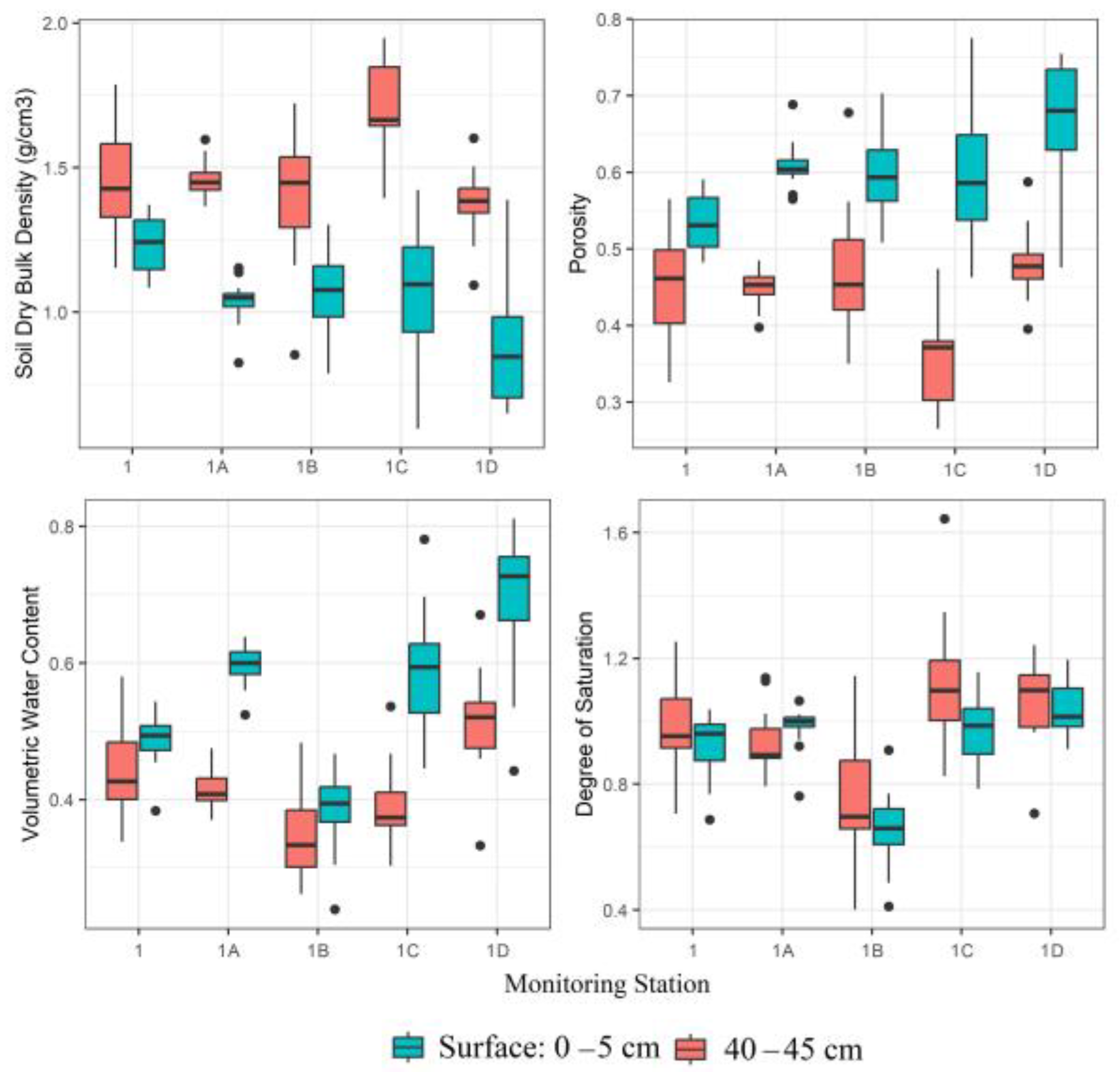
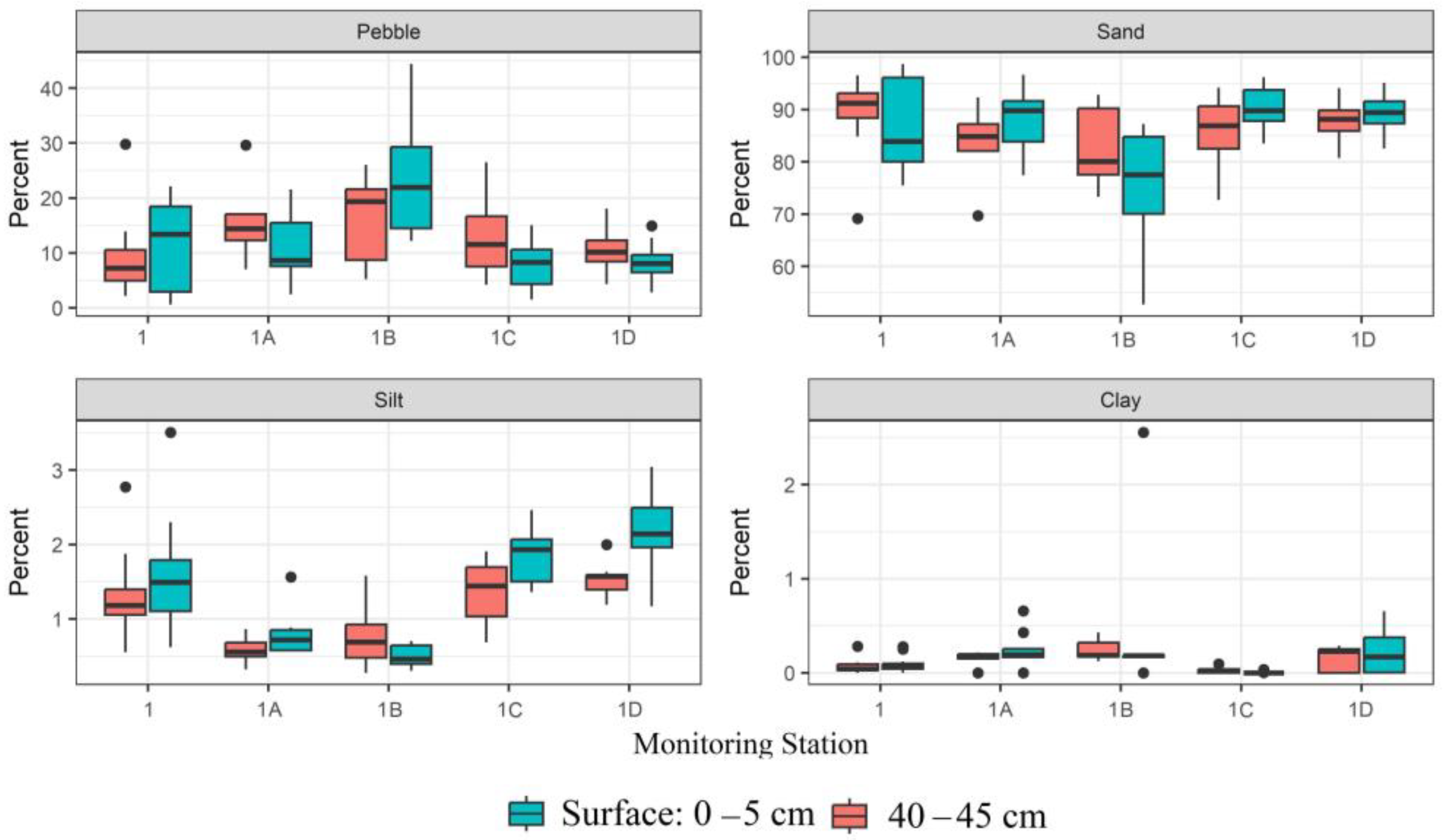
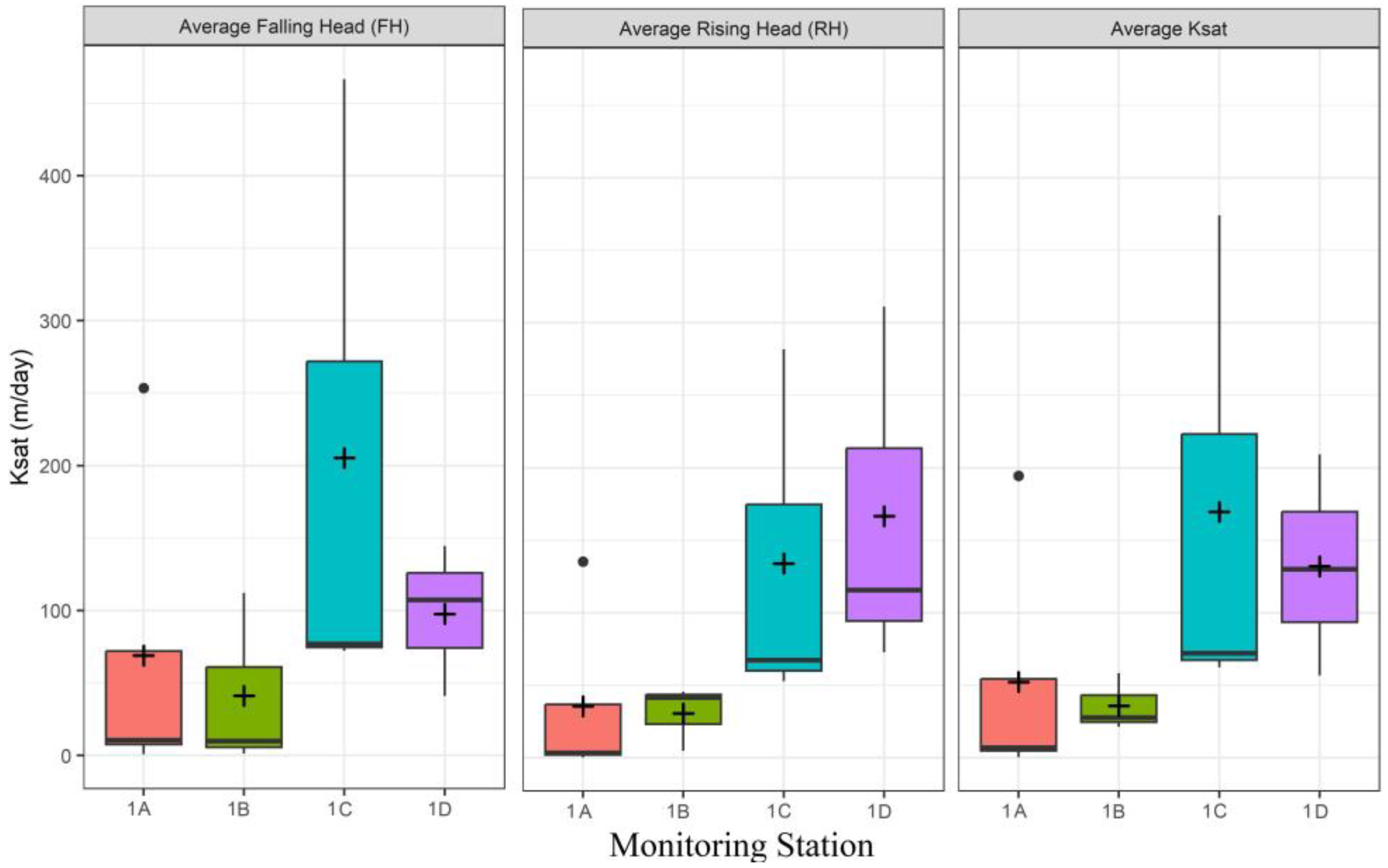
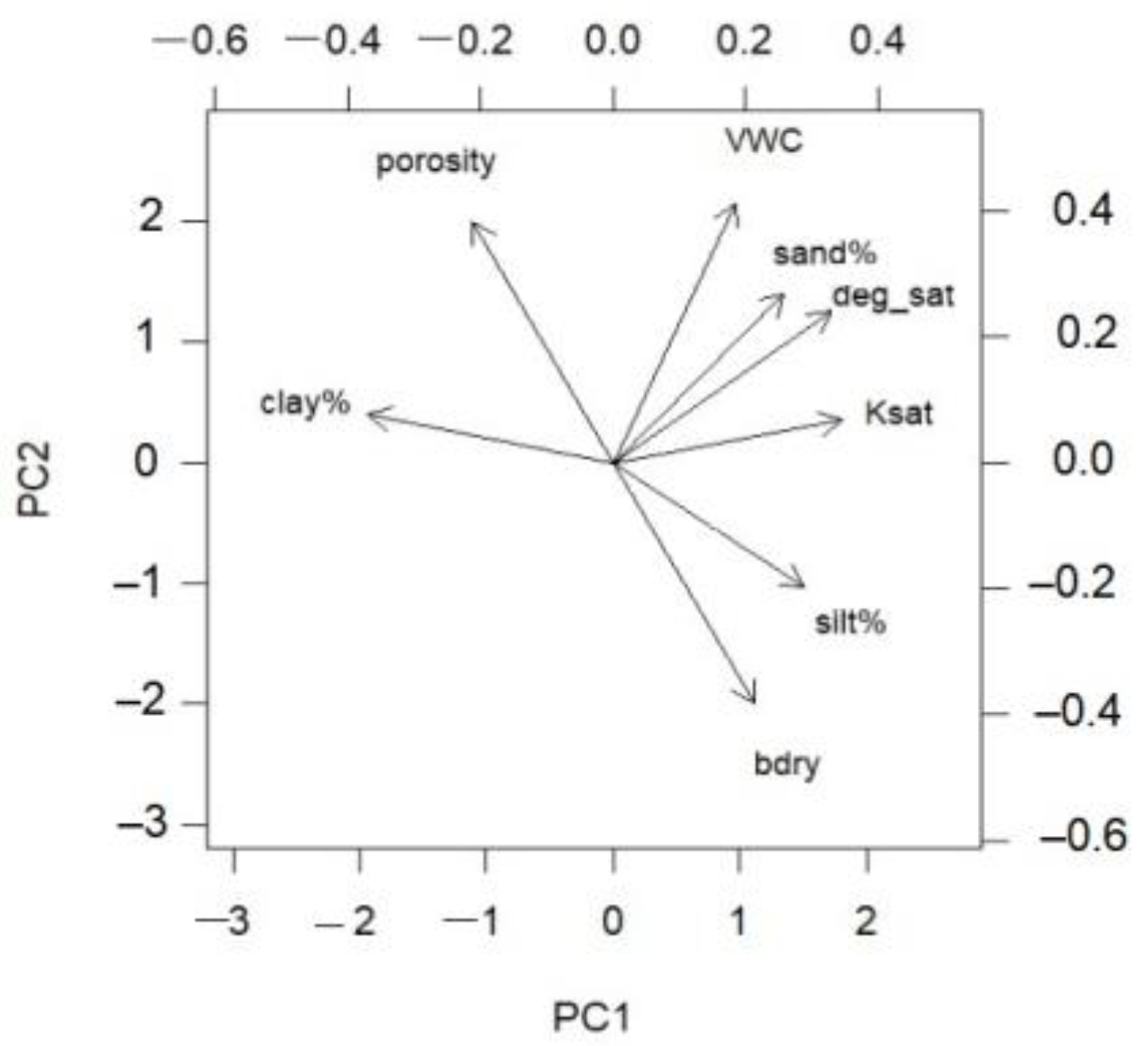
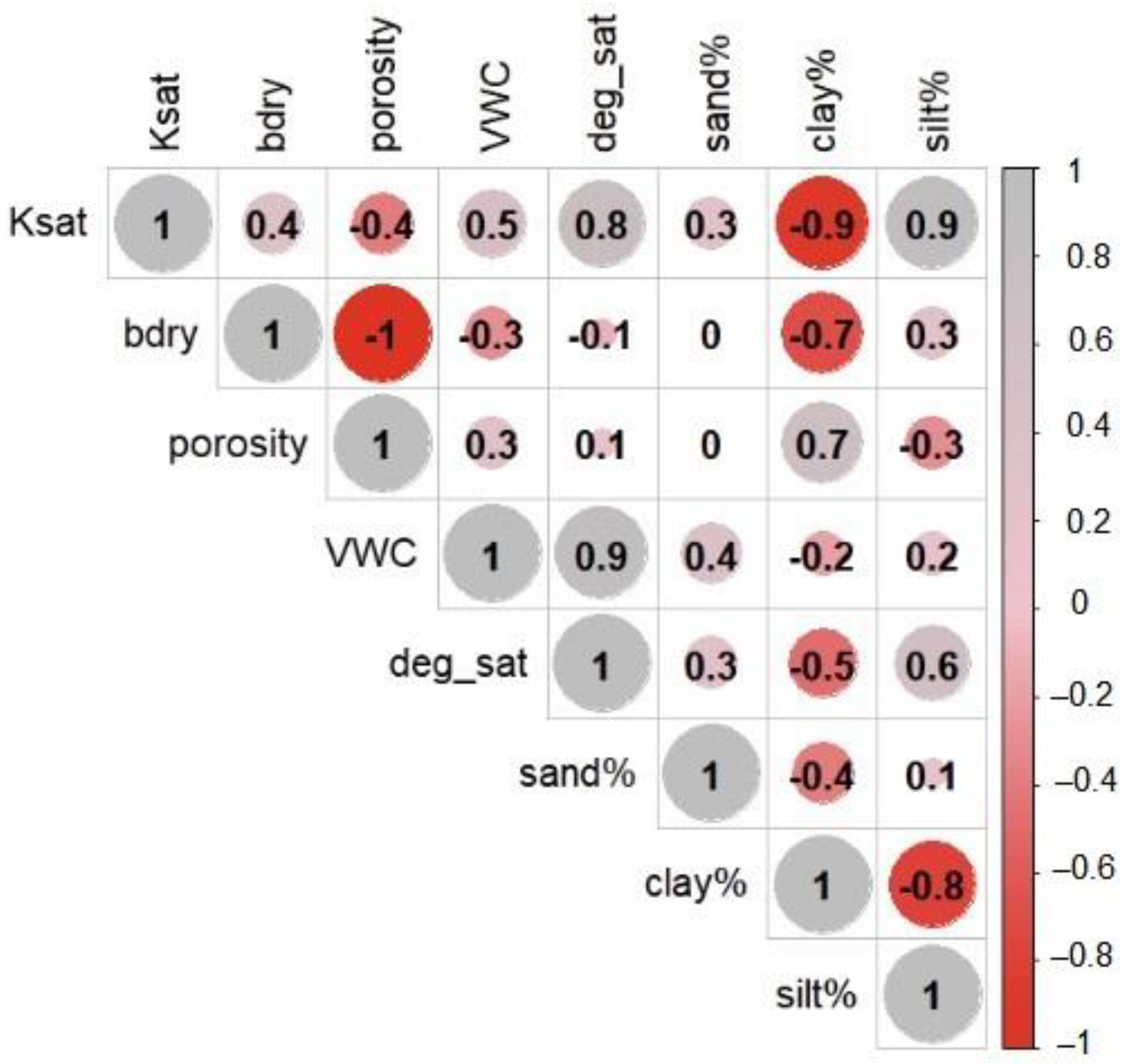
| Texture | Site 1 | Site 1A | Site 1B | Site 1C | Site 1D |
|---|---|---|---|---|---|
| Pebble | 10.16 | 12.20 | 20.27 | 13.02 | 10.09 |
| Medium Sand | 66.18 | 67.41 | 57.16 | 60.38 | 57.09 |
| Fine Sand | 22.14 | 19.35 | 21.36 | 24.89 | 30.57 |
| Total Sand | 88.32 | 86.75 | 78.53 | 85.27 | 87.66 |
| Silt | 1.44 | 0.87 | 0.95 | 1.66 | 2.08 |
| Clay | 0.08 | 0.17 | 0.25 | 0.05 | 0.17 |
| Monitoring Sites | FH Ksat | RH Ksat | Average Ksat |
|---|---|---|---|
| 1A | 68.92 (0.88, 253.52) | 35.57 (0.02, 135.38) | 52.25 (0.54, 194.45) |
| 1B | 41.12 (1.21, 112.08) | 30.68 (4.80, 45.59) | 35.90 (21.43, 58.44) |
| 1C | 205.25 (72.20, 466.54) | 134.03 (52.80, 281.91) | 169.64 (62.50, 374.22) |
| 1D | 97.62 (40.96, 144.44) | 166.63 (72.82, 311.31) | 132.12 (56.89, 209.38) |
| Principal Component | PC1 | PC2 | PC3 | PC4 | PC5 |
|---|---|---|---|---|---|
| Eigenvalue | 2.06 | 1.69 | 0.87 | 0.32 | 0 |
| Proportion of variance | 0.53 | 0.36 | 0.09 | 0.01 | 0 |
| Cumulative Proportion | 0.53 | 0.89 | 0.98 | 1 | 1 |
| Soil Properties | PC1 | PC2 |
|---|---|---|
| Ksat | 0.43 | 0.08 |
| Bdry | 0.27 | −0.48 |
| Porosity | −0.27 | −0.48 |
| VWC | 0.23 | 0.51 |
| Degree of saturation | 0.41 | 0.30 |
| Sand% | 0.31 | 0.33 |
| Clay% | −0.46 | 0.09 |
| Silt% | 0.36 | −0.25 |
| PTF Method | Site 1 | Site 1A | Site 1B | Site 1C | Site 1D |
|---|---|---|---|---|---|
| Puckett et al. | 3.77 | 3.77 | 3.77 | 3.78 | 3.77 |
| Smettem and Bristow | 7.49 | 6.49 | 6.04 | 8.02 | 6.50 |
| Cosby et al. | 0.62 | 0.62 | 0.62 | 0.62 | 0.62 |
| Dane and Puckett | 7.29 | 7.29 | 7.28 | 7.29 | 7.29 |
| Campbell and Shiozawa | 1.15 | 1.18 | 1.16 | 1.14 | 1.09 |
| Puckett et al. [11] | Smettem and Bristow [51] | Cosby et al. [13] | Dane and Puckett [55] | Campbell and Shiozawa [56] | ||||||
|---|---|---|---|---|---|---|---|---|---|---|
| Sites | Error | Squared Error | Error | Squared Error | Error | Squared Error | Error | Squared Error | Error | Squared Error |
| 1 | −93.71 | 8782.22 | −89.99 | 8098.45 | −96.86 | 9382.67 | −90.19 | 8133.98 | −96.32 | 9278.08 |
| 1A | −48.48 | 2350.72 | −45.76 | 2093.61 | −51.63 | 2666.11 | −44.96 | 2021.37 | −51.07 | 2607.63 |
| 1B | −32.13 | 1032.65 | −29.86 | 891.90 | −35.28 | 1245.00 | −28.61 | 818.56 | −34.74 | 1206.71 |
| 1C | −165.87 | 27,513.95 | −161.62 | 26,120.41 | −169.02 | 28,569.38 | −162.35 | 26,357.00 | −168.50 | 28,390.83 |
| 1D | −128.35 | 16,474.80 | −125.61 | 15,779.00 | −131.50 | 17,293.30 | −124.83 | 15,582.43 | −131.03 | 17,168.94 |
| ME | −93.71 | −90.57 | −96.86 | −90.19 | −96.33 | |||||
| SSE | 56,154.34 | 52,983.38 | 59,156.47 | 52,913.34 | 58,652.2 | |||||
| RMSE | 105.98 | 102.94 | 108.77 | 102.87 | 108.31 | |||||
Disclaimer/Publisher’s Note: The statements, opinions and data contained in all publications are solely those of the individual author(s) and contributor(s) and not of MDPI and/or the editor(s). MDPI and/or the editor(s) disclaim responsibility for any injury to people or property resulting from any ideas, methods, instructions or products referred to in the content. |
© 2023 by the authors. Licensee MDPI, Basel, Switzerland. This article is an open access article distributed under the terms and conditions of the Creative Commons Attribution (CC BY) license (https://creativecommons.org/licenses/by/4.0/).
Share and Cite
Abesh, B.F.; Hubbart, J.A. A Comparison of Saturated Hydraulic Conductivity (Ksat) Estimations from Pedotransfer Functions (PTFs) and Field Observations in Riparian Seasonal Wetlands. Water 2023, 15, 2711. https://doi.org/10.3390/w15152711
Abesh BF, Hubbart JA. A Comparison of Saturated Hydraulic Conductivity (Ksat) Estimations from Pedotransfer Functions (PTFs) and Field Observations in Riparian Seasonal Wetlands. Water. 2023; 15(15):2711. https://doi.org/10.3390/w15152711
Chicago/Turabian StyleAbesh, Bidisha Faruque, and Jason A. Hubbart. 2023. "A Comparison of Saturated Hydraulic Conductivity (Ksat) Estimations from Pedotransfer Functions (PTFs) and Field Observations in Riparian Seasonal Wetlands" Water 15, no. 15: 2711. https://doi.org/10.3390/w15152711
APA StyleAbesh, B. F., & Hubbart, J. A. (2023). A Comparison of Saturated Hydraulic Conductivity (Ksat) Estimations from Pedotransfer Functions (PTFs) and Field Observations in Riparian Seasonal Wetlands. Water, 15(15), 2711. https://doi.org/10.3390/w15152711







